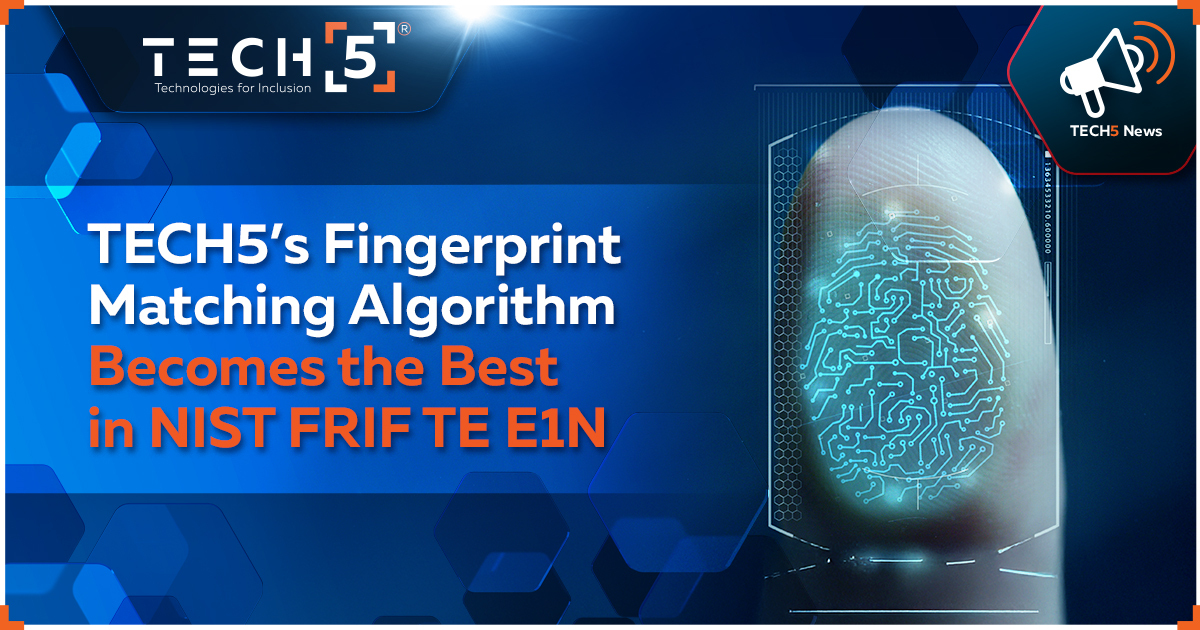
TECH5, an innovator in the field of biometrics and digital identity, shows the best result in the NIST FRIF TE E1N evaluation, outperforming competition on accuracy, speed, and efficiency. TECH5’s latest submission to NIST FRIF TE E1N was on August 11th, 2025. TECH5 is one of the first companies to successfully complete the evaluation.
Formerly, it was known as FpVTE and was conducted previously in 2012. FRIF E1N is a relaunch of previous evaluations conducted by NIST under the FpVTE moniker. Now, global governments can use the latest evaluation instead of the results from 2012.
“This evaluation was highly needed, because the previous similar 1:N fingerprint NIST testing was conducted 13 years ago under FpVTE. The end customers are looking at these tests as a reference when selecting large-scale ABIS (Automated Biometric Identification System) platforms for their projects in civil identity, foundational identity, elections, passport systems and the like. We at TECH5 are very proud that this fingerprint algorithm, that is used in the T5-OmniMatch ABIS platform, shows the best results.” – says TECH5 Chief Revenue Officer Ameya Bhagwat.
Friction Ridge Image and Features (FRIF) Technology Evaluation (TE) Exemplar One-to-Many (E1N or 1:N), or FRIF TE E1N, is an open-set identification evaluation of algorithms that automatically extract and use features from all types of exemplar friction ridge images (e.g., rolled fingerprints, palm prints, slaps) and use those features to search for similar candidates in databases of millions of subjects. This is a complicated testing as success depends on end-to-end behavior across many capture types (index pairs, slaps, 10-print plain and rolled), sometimes with vendor-performed slap segmentation, correct finger/region “location” reporting, and strict speed caps while searching millions of subjects. Building enrollment databases, meeting average search-time limits, and balancing FPIR vs. FNIR across these scenarios all need to work simultaneously, and NIST publishes only submissions that meet the speed requirements. “Performing well, therefore, demonstrates not just an accurate matcher but a production-ready pipeline: robust feature extraction and segmentation, efficient indexing/search, sensible thresholds at low FPIR, and storage designed to scale to the demands of the national system.” – comments Vishesh Mistry, Senior AI Scientist at TECH5.
TECH5 outperforms competition in both accuracy and efficiency across the two out of three datasets—Class A (index fingers) and Class C (ten fingers). On Class A’s 1.6M both-index search, TECH5 posts a lower miss rate at an operational threshold (FNIR @ FPIR≤0.001: 0.001) and a better Rank-1 FNIR (0.0004), showing higher accuracy at the top of the candidate list. On Class C’s 5M ten-finger searches, TECH5’s algorithm is the best across all pairings — Plain-Plain (0.0018), Plain-Rolled (0.0006), and Rolled-Rolled (0.0003) — and leads on Rank-1 FNIR (0.0042/0.0037/0.0034), demonstrating stronger identification performance at scale.
TECH5’s algorithm also showed a higher template creation speed: template creation is ~2× quicker, making Identification Flats in ~3.7–3.8s. TECH5’s technology comes with a smaller template size than that of a competition, which is especially important for matching using mobile devices: for example, Ten Fingers Plain is approximately 29 kB, which translates into lower compute and storage costs. At deployment-scale database sizes, TECH5’s enrollment footprint is also smaller, supporting more economical, high-throughput operations.
“We are committed to provide our partners and customers with the best biometric capture and matching technologies. This was our first NIST FRIF TE E1N submission, and we are confident that our future submissions will demonstrate significant improvements.” – comments Rahul Parthe, Co-Founder and CTO at TECH5.
The results are publicly available on the NIST’s website.
